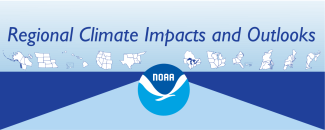
NOAA and its partners have released the latest Regional Climate Impacts and Outlooks, which recap summer conditions and provide insight into what might be expected this fall.
Summer Temperature Recap
The meteorological summer (June-August) average temperature for the contiguous U.S. was 73.0°F, 1.6°F above average, ranking 15th warmest on record. Temperatures were above average across much of the West and in parts of the Upper Midwest, Southern Plains, Northeast and along the Gulf of Mexico and East Coast. Temperatures were below average in parts of the west-central Plains, Ohio Valley and Southeast. Louisiana ranked warmest on record, while Texas and Florida each ranked second warmest for this summer season. Four additional states ranked among their top-10 warmest on record for this period. Based on NOAA's Residential Energy Demand Temperature Index (REDTI), the contiguous U.S. temperature-related energy demand for June–August was 184 percent of average and the 12th-highest value in the 129-year period of record.
Summer Precipitation Recap
The contiguous U.S. summer precipitation total was 8.35 inches, 0.03 inch above average, ranking in the middle third of the June-August record.
Precipitation was above average across much of California, the interior West and Northeast, and in parts of the central to northern Plains, Ohio Valley and Southeast. Wyoming, Vermont and New Hampshire each ranked wettest on record, while five additional states ranked among their top-10 wettest during the June–August period. Summer precipitation was below average in parts of the Northwest, Southwest, southern Plains, Upper Midwest, Mid-Atlantic and Southeast. New Mexico and Louisiana each ranked third driest with four additional states ranking among their top-10 driest summer season on record.
Fall Temperature Outlook
The October–December 2023 temperature outlook favors above normal temperatures for Alaska, the western third of the Contiguous United States (CONUS), the Northeast, Great Lakes, parts of the Southern Plains, Florida, and the immediate Gulf and East Coasts. The largest probabilities (greater than 60 percent) of above normal temperatures are forecast across the North Slope of Alaska. Above normal temperatures are also likely (probabilities greater than 50 percent) for parts of the Pacific Northwest and northern New England.
Fall Precipitation Outlook
The October–December 2023 precipitation outlook depicts enhanced probabilities of above normal precipitation amounts across the Southeast, Southern Plains, and parts of the mid-Atlantic states as well as northern and western Alaska. The greatest chances of above normal precipitation (above 50 percent probability) are indicated for parts of northern Florida and southern Georgia.
Impacts and Outlooks for Your Region
Get more details for your region in the September 2023 climate impacts and outlooks summaries:
- Alaska and Northwestern Canada Region (coming soon)
- Great Lakes Region
- Gulf of Maine Region
- Mid-Atlantic Region (coming soon)
- Midwest Region
- Missouri River Basin Region
- Northeast Region
- Pacific Region
- Prairies and High Plains Region
- Southeast Region
- Southern Region
- Western Region
Creating These Quarterly Summaries
NOAA’s Regional Climate Services lead the production of these quarterly summaries of climate impacts and outlooks for various regions of the United States as well as parts of Canada along the border. This effort, which began in 2012, includes 12 unique regional products that are produced collaboratively with partner organizations.
You can access all of the Climate Impacts and Outlooks summaries as well as additional reports and assessments through the U.S. Drought Portal Reports web page at Drought.gov.



